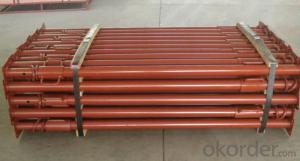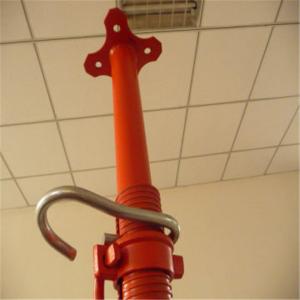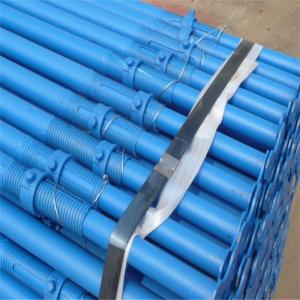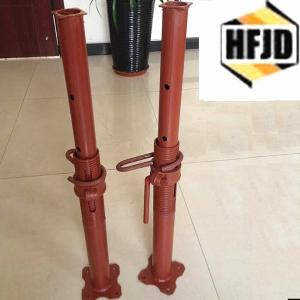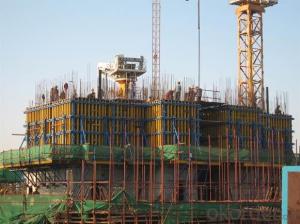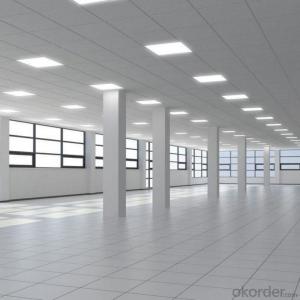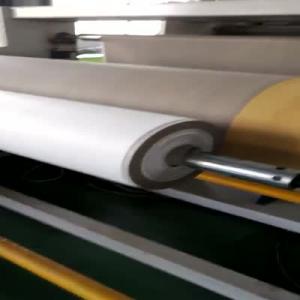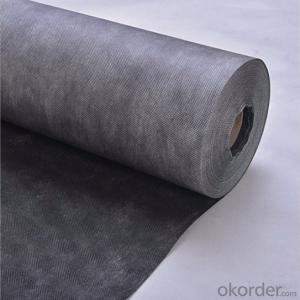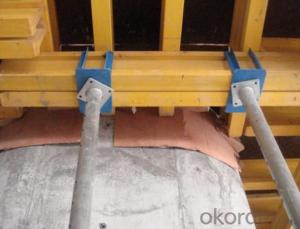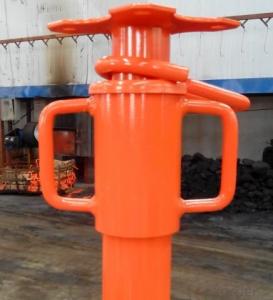telescopic props scaffolding props steel props
- Loading Port:
- China Main Port
- Payment Terms:
- TT OR LC
- Min Order Qty:
- -
- Supply Capability:
- -
OKorder Service Pledge
OKorder Financial Service
You Might Also Like
Quick Details
| Model Number: | |||||
| Type: | Scaffolding Part Type: | Material: | |||
| Surface treatment: | Color: | Technique: | |||
| Length: | Inner tube diameter: | Outer tube diameter: | |||
| Thickness: | Application: | Certification: |
Packaging & Delivery
| Packaging Detail: | 1.props scaffolding props steel props is in a bundle with a wire which is in bare package. 2.One 20 GP container can load almost 1500-2000 pieces of props. |
| Delivery Detail: | 10-20 days after deposit |
Specifications
props scaffolding props steel props
1.For slab supporting
2.CO2 arc welded technique
3.High loading capacity
4.Rust-proof
Features
1. One pieces of props scaffolding props steel props consists of internal tube, external tube, prop nut, base plate, and top plate.
2. props scaffolding props steel props can be adjusted to any length within its range which is convenient for using.
3.With its simple structure, props scaffolding props steel props is easy to assemble and dismantle which can help to save your time, labor, and cost.
4.We have several kinds of props scaffolding props steel props which are Middle East type props scaffolding props steel props , Spanish props scaffolding props steel props and Italian type props scaffolding props steel props . They are popular in Africa,South America,South Asia, and Asia etc.
5. props scaffolding props steel props is for supporting concrete slab, beam, timber, and formwork which is strong and reliable for interior building construction.
6.We can weld the flat plate or the flower plate at the top of the props scaffolding props steel props as your requirement.
SpecificationsChina)
| Product | Model | Specifications |
props scaffolding props steel props | Inner tube diameter |
40/48mm |
| Outer tube diameter |
48/56/60mm | |
| Tube thickness |
1.8/2.0/2.2/2.5/3mm | |
| Adjustable length | 1600-2900mm 1800-3200mm 2000-3600mm 2200-4000mm |
- Q:How do steel props compare to hydraulic shores in terms of safety?
- Steel props and hydraulic shores are both commonly used in construction to provide temporary support to structures. In terms of safety, both options have their advantages and considerations. Steel props are typically more rigid and can handle heavier loads, offering stability and reliability. However, they require manual adjustment and might not be as adaptable to uneven surfaces. On the other hand, hydraulic shores offer the advantage of adjustable height and easy installation, making them suitable for quick and efficient support. Nevertheless, their reliance on hydraulic pressure introduces the risk of leaks or sudden failure. Ultimately, the choice between steel props and hydraulic shores should be based on the specific project requirements and a thorough assessment of safety considerations.
- Q:Are steel props resistant to rust and corrosion?
- Yes, steel props are generally resistant to rust and corrosion due to their durable and protective coating.
- Q:Can steel props be used in supporting temporary retaining walls?
- Yes, steel props can be used in supporting temporary retaining walls. Steel props are commonly used in construction projects to provide temporary support and stability to structures such as walls, beams, and floors. They are adjustable and can be easily installed, making them suitable for supporting temporary retaining walls. Steel props are designed to withstand heavy loads and provide the necessary support required for retaining walls. They are also versatile and can be used in various construction applications. However, it is essential to consult with a structural engineer or a construction professional to ensure that the steel props are appropriately sized and positioned to support the specific requirements of the temporary retaining wall.
- Q:How do you calculate the required spacing between steel props?
- Calculating the required spacing between steel props involves considering several factors to ensure the safe and efficient support of a structure. Here are the key steps involved in this calculation: 1. Determine the load: Start by determining the load that the steel props need to support. This includes the weight of the structure, any additional live loads, and any concentrated loads that may be present. 2. Determine the load-bearing capacity of the props: Next, assess the load-bearing capacity of the steel props being used. This information can typically be obtained from the manufacturer's specifications or load tables. It is important to consider both the maximum axial load and the maximum moment capacity of the props. 3. Calculate the total load on each prop: Divide the total load by the number of props to determine the load that each individual prop needs to support. Ensure that the individual prop load does not exceed the load-bearing capacity of the props. 4. Consider the spacing limitations: Determine any spacing limitations based on the specific requirements of the project or the manufacturer's guidelines. These may include maximum and minimum spacing requirements, which could be influenced by factors such as the prop's length, stability, or bracing requirements. 5. Account for the prop's deflection: Steel props will deflect under load, and this deflection must be taken into account when calculating the spacing. Typically, a maximum allowable deflection limit is provided by the manufacturer. Ensure that the spacing is such that the deflection of each prop remains within this limit. 6. Calculate the required spacing: Divide the maximum allowable deflection by the deflection of each prop under load to determine the number of props needed to achieve the desired spacing. It is important to ensure that the resulting number of props is practical and feasible within the given project constraints. 7. Consider additional factors: Finally, consider any additional factors that may impact the spacing calculation, such as wind loads, seismic loads, or any other relevant design considerations. These factors may require adjustments to the spacing calculation to ensure the stability and safety of the structure. It is crucial to consult with a structural engineer or a qualified professional during the calculation process to ensure accuracy and adherence to safety standards and local building codes.
- Q:Steel support is now about how much the price
- Steel support prices will follow the market price of steel, and now probably about 3800 yuan / ton, of course, one day a price.
- Q:Are steel props suitable for supporting temporary seating structures?
- Temporary seating structures can be effectively supported by steel props. These props, also known as adjustable steel props or acrow props, are widely used in construction and temporary structures to provide stability and support. Their adjustable height feature makes them versatile and adaptable for various applications, including supporting temporary seating structures. By virtue of their durable steel construction, steel props offer a robust and dependable support system. They are capable of bearing heavy loads and can be easily adjusted to the desired height, thereby facilitating flexibility when setting up temporary seating structures. Furthermore, steel props are highly practical for temporary structures due to their ease of installation and removal. They can be swiftly assembled and disassembled, saving time and effort during the setup and dismantling process. Moreover, steel props guarantee a high level of stability and safety. Equipped with sturdy base plates, they provide a solid foundation and prevent sinking into the ground. This ensures the seating structure remains stable and secure, even when accommodating a large number of people. Overall, steel props are a suitable and reliable choice for supporting temporary seating structures. Their strength, adjustability, ease of installation, and stability make them an ideal support system that can withstand heavy loads and ensure the safety and comfort of users.
- Q:Can steel props be used for supporting temporary signage or billboards?
- Indeed, temporary signage or billboards can be supported by steel props. Their strength and sturdiness render them appropriate for upholding hefty and sizable signs. With ease, they can be effortlessly adjusted and firmly fastened, thereby ensuring stability for the signage or billboard. Moreover, steel props possess versatility, enabling their utilization within diverse outdoor environments such as construction sites, events, and public areas. In this manner, they provide a dependable remedy for temporary signage requirements, guaranteeing secure and conspicuous displays for the intended audience.
- Q:What are the maximum load capacities for different steel prop sizes?
- The maximum load capacities for different steel prop sizes vary depending on various factors such as the specific steel prop design, material strength, and length. It is crucial to refer to the manufacturer's specifications or consult with a structural engineer to determine the exact maximum load capacity for each steel prop size.
- Q:Can steel props be used in the construction of tunnels or underground railways?
- Indeed, tunnels or underground railways can utilize steel props in their construction. These props are frequently employed in excavation-heavy ventures, like tunnels and underground railways, to offer structural reinforcement and maintain the stability of the nearby soil or rock, thereby averting potential collapses. Steel props are engineered to endure substantial burdens and possess adjustable heights, rendering them adaptable and appropriate for a range of tunneling and underground construction purposes. Moreover, their straightforward installation and removal make them a cost-efficient and productive option for supporting tunnel and underground railway construction endeavors.
- Q:What are the common maintenance costs associated with steel props?
- The common maintenance costs associated with steel props can vary depending on the specific usage and conditions, but there are a few key areas where costs may arise. Firstly, regular cleaning and inspection of the props is essential to ensure their longevity and efficient functioning. This may involve removing dirt, debris, or rust from the steel surface, as well as lubricating any moving parts to prevent friction and wear. Secondly, there may be costs associated with replacing or repairing damaged or worn-out components of the props. This could include replacing damaged pins or clips, repairing bent or dented parts, or even replacing entire sections of the prop if necessary. Another potential maintenance cost is the need for periodic load testing or certification to ensure that the props meet the required safety standards. This may involve hiring specialized equipment or personnel to carry out the testing, as well as any necessary repairs or adjustments to bring the props into compliance. Additionally, if the steel props are used in corrosive or harsh environments, there may be ongoing costs associated with applying protective coatings or treatments to prevent rust and corrosion. This could include regular applications of paint or anti-corrosion coatings, as well as any necessary repairs or touch-ups to maintain the effectiveness of the protective layer. Overall, the maintenance costs associated with steel props can vary depending on factors such as usage, environment, and the level of care and maintenance provided. However, regular cleaning, inspection, repair, load testing, and protective coatings are some of the common areas where costs may arise.
1. Manufacturer Overview |
|
|---|---|
| Location | |
| Year Established | |
| Annual Output Value | |
| Main Markets | |
| Company Certifications | |
2. Manufacturer Certificates |
|
|---|---|
| a) Certification Name | |
| Range | |
| Reference | |
| Validity Period | |
3. Manufacturer Capability |
|
|---|---|
| a)Trade Capacity | |
| Nearest Port | |
| Export Percentage | |
| No.of Employees in Trade Department | |
| Language Spoken: | |
| b)Factory Information | |
| Factory Size: | |
| No. of Production Lines | |
| Contract Manufacturing | |
| Product Price Range | |
Send your message to us
telescopic props scaffolding props steel props
- Loading Port:
- China Main Port
- Payment Terms:
- TT OR LC
- Min Order Qty:
- -
- Supply Capability:
- -
OKorder Service Pledge
OKorder Financial Service
Similar products
New products
Hot products
Hot Searches
Related keywords
